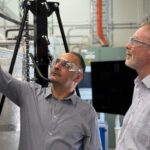A quest to study the earliest stars and galaxies in the Universe is underway, with local industry building the first major pieces of a revolutionary new radio telescope in Western Australia, as part of the Murchison Wide-field Array.
Murchison Wide-field Array (MWA) industry partner and Fremantle-based high-technology company, Poseidon Scientific Instruments (PSI), has been awarded a $1.3m contract by Curtin University to build 16 packages of sensitive electronics, using a smart design suited to the environmental and radio-quiet conditions of outback WA.
The MWA is being built by an Australian consortium led by The International Centre for Radio Astronomy Research (ICRAR), a joint venture between Curtin University and The University of Western Australia, in close collaboration with US, Indian and New Zealand partners.
ICRAR Deputy Director, Professor Steven Tingay, said PSI was a world-class technology company and working with its local expertise to design and develop components for the international project was an enormous advantage.
“PSI will build 16 electronics packages for the MWA, the culmination of more than two years of collaboration in which PSI have been deeply involved in the design cycle. They are a valued collaborator, not just another cog in the supply chain,” Professor Tingay said.
Professor Tingay said the innovative package would also prevent the electronics from interfering with other equipment on the site, preserving the uniquely radio-quiet environment of the Murchison.
“The combination of the MWA and the radio-quiet environment of the Murchison will allow us to search for the incredibly weak signals that come from the early stages in the evolution of the Universe, some 13 billion years ago,” he said.
The MWA is located at the Murchison Radio-Astronomy Observatory, a site operated by CSIRO and a proposed core site for the multi-billion dollar Square Kilometre Array (SKA).
The MWA will be the first of three official SKA precursor telescopes to be completed, proving the technology and science on the path to the SKA. Australia and New Zealand are bidding to host the SKA, with the site location to be decided in February 2012.
One of ICRAR’s goals is to partner with Australian industries to help position them to participate in future radio astronomy opportunities, such as the SKA. The MWA partnership with PSI is one such success story.
Contacts:
Professor Steven Tingay, ICRAR Deputy Director, Curtin University
Tel: 08 9266 3516, Mobile: 0425 771 856 Email: steven.tingay@icrar.org
Andrea Barnard, Public Relations, Curtin University
Tel: 08 9266 4241, Mobile: 0401 103 755, Email: andrea.barnard@curtin.edu.au


